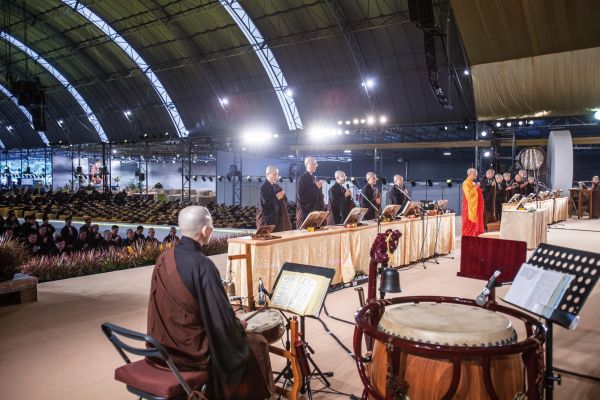Special Topics
A Brief Introduction to the Development of the Dharma Assembly
 The Dharma assembly refers to the various kinds of gathering events, which can include Dharma talks, offerings to the Buddha, offerings to monastics, and providing alms. The primary essence of the Dharma assembly is "to encounter and practice Dharma”. What was the original meaning of Dharma assemblies? Were there any Dharma assemblies during the Buddha's time? What would be the significance of attending Dharma assemblies in modern times?
The Dharma assembly refers to the various kinds of gathering events, which can include Dharma talks, offerings to the Buddha, offerings to monastics, and providing alms. The primary essence of the Dharma assembly is "to encounter and practice Dharma”. What was the original meaning of Dharma assemblies? Were there any Dharma assemblies during the Buddha's time? What would be the significance of attending Dharma assemblies in modern times?After the Buddha attained enlightenment, he preached along the Ganges and gave Dharma talks in accordance with various kinds of audiences present. During that time, gatherings consisting of the Buddha's talks, precept recitation, and making offerings could be considered the early prototypes of the Dharma assembly. After the Buddha entered nirvana, his disciple Venerable Mahakasyapa convened 500 great arhats to recite sutras. Through chanting and oral recitation of the Buddha's teachings, the Buddha's disciples were able to share and propagate the Dharma.
In addition to chanting the sutras, monks and lay disciples built stupas in many places. Every morning and evening, Buddhists circumambulated the stupas, prostrated, made offerings with flowers and incense, and praised the Buddha's merit by reciting verses. Buddhist relics and stupas became a symbolic place where Buddhists could visit and make pilgrimages. Eventually, these places started to host regular Dharma assemblies--- for example, on the commemorative days of the Buddha's birth, enlightenment, first preaching, nirvana, and more.
As the Dharma assembly evolved and developed with time, it became no longer limited to only Dharma talks and chanting. Current Dharma assemblies encompass different types of practice methods. In addition to Dharma talks and sutra recitation, today's Dharma assemblies also conduct chanting, offerings, Buddha name recitation, prostration, upholding mantras or dharanis, visualization, etc. This format is quite different from in the Buddha's time when the Dharma assembly was mainly a gathering to hear and recite the Buddha's teachings.
Regardless of whether it is an original Dharma assembly which exclusively conducted Buddha's talks and sutra recitation or a modern one that integrates practice into its rituals, the ultimate goal is to help practitioners realize why the Buddha gave us the Dharma---that is, to help all sentient beings be liberated from suffering and attain Buddhahood.
Resource: Issue 375 of Life Magazine, Dharma Drum Publishing Corporation
Text: Editorial Team, Dharma Drum Publishing Corporation
Translation: Hsiao Chen-an
Editing: Carrie, Keith Brown
Extended Reading:
Into the Venue of a Dharma Assembly
What Should We Bring to a Dharma Assembly?
Dharma Assembly Attendee Etiquette
Ten Most Commonly Seen Dharma Assemblies in Chinese Buddhism
The Contents of Dharma Services
Attending Dharma Assemblies: Prepare Well, Avoid Hasty Effort
To Learn About Other Topics, Please Go HERE!
In addition to chanting the sutras, monks and lay disciples built stupas in many places. Every morning and evening, Buddhists circumambulated the stupas, prostrated, made offerings with flowers and incense, and praised the Buddha's merit by reciting verses. Buddhist relics and stupas became a symbolic place where Buddhists could visit and make pilgrimages. Eventually, these places started to host regular Dharma assemblies--- for example, on the commemorative days of the Buddha's birth, enlightenment, first preaching, nirvana, and more.
As the Dharma assembly evolved and developed with time, it became no longer limited to only Dharma talks and chanting. Current Dharma assemblies encompass different types of practice methods. In addition to Dharma talks and sutra recitation, today's Dharma assemblies also conduct chanting, offerings, Buddha name recitation, prostration, upholding mantras or dharanis, visualization, etc. This format is quite different from in the Buddha's time when the Dharma assembly was mainly a gathering to hear and recite the Buddha's teachings.
Regardless of whether it is an original Dharma assembly which exclusively conducted Buddha's talks and sutra recitation or a modern one that integrates practice into its rituals, the ultimate goal is to help practitioners realize why the Buddha gave us the Dharma---that is, to help all sentient beings be liberated from suffering and attain Buddhahood.
Resource: Issue 375 of Life Magazine, Dharma Drum Publishing Corporation
Text: Editorial Team, Dharma Drum Publishing Corporation
Translation: Hsiao Chen-an
Editing: Carrie, Keith Brown
Extended Reading:
Into the Venue of a Dharma Assembly
What Should We Bring to a Dharma Assembly?
Dharma Assembly Attendee Etiquette
Ten Most Commonly Seen Dharma Assemblies in Chinese Buddhism
The Contents of Dharma Services
Attending Dharma Assemblies: Prepare Well, Avoid Hasty Effort
To Learn About Other Topics, Please Go HERE!
